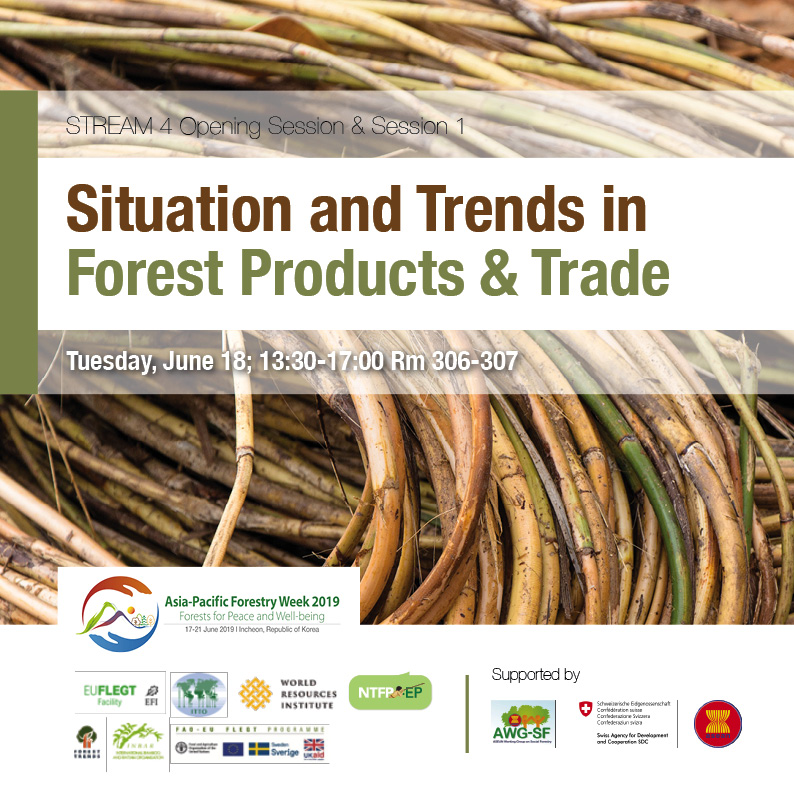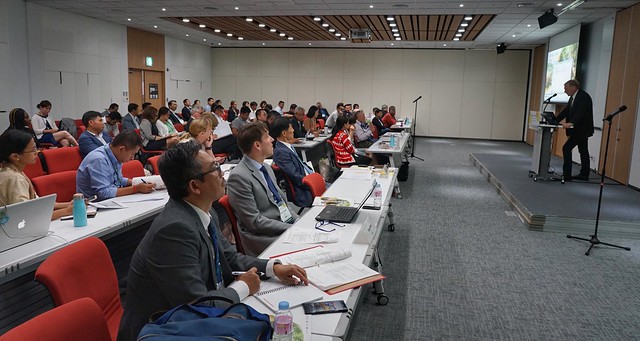There is vast potential for timber sector to learn from NTFP experiences working with SMEs/communities; and for NTFP producers to benefit from experience of timber sector with legality assurance systems/information collection and management.
There is also potential for sustainable NTFP production (especially bamboo), but also risks of overexploitation of NTFPs if market demand raises while green and fair-trade arrangements are not yet developed.
There should be a balance between the attention and work on the supply as well as the demand side (consumers’ side). Multi-sectoral collaboration and stronger and inclusive policy work and analysis for supply and demand aspects of timber and non-timber forest products should be undertaken.
Community based forest enterprises (CFEs) are empowering and effective mechanisms that capture, conserve and communicate multiple values (economic, ecological, cultural, spiritual, etc.) of forests.

- Around 100 people attended the event; 6 speakers, two on timber and three on NTFPs and one on market intelligence.
- Many tropical producing countries are in multi-stakeholder dialogues regulating and governing timber legality such as through FLEGT VPAs; their trade is increasingly monitored;
- Important changes in value chains in the Asia-Pacific region take place: more timber comes from plantations (IDN, VN), there is an increasing role of small and micro-businesses in timber and timber product production, and several producing countries increase and regulate their own timber imports. These changes result in needs or potentials for regulatory reforms, and space for innovations in timber legality and sustainability assurance mechanisms;
- China remains the main global timber market and imports timber to serve its domestic market and exports; regional and global reflections on legal and sustainable timber trade need to address China’s role.
- The engagement although still mostly informal but increasingly becoming more organized community forest enterprise or MSMEs around NTFPs; various initiatives on sustainable production and marketing where lessons and potentials are seen
- The demand for quality/standard developments for NTFPs utilizing local/traditional ecological knowledge and sustainability values and dimensions;
- The importance of small and micro-businesses in the NTFP sector, and their needs wrt tenure security, access to markets, information and finance;
- The potential for sustainable NTFP production (Bamboo), but also risks of overexploitation of NTFPs if market demand raises while green and fair-trade arrangements are not yet developed.
- Data issues remain – some improvements in the timber sector (also related to transparency and tools), but still too little understanding of dynamics of NTFPs;
- Joint efforts by governments, CSOs, research and the industry on the supply and demand side are needed.
- Timber side has a lot of experience with irresponsible trade and market. Timber and NTFP sides can learn from each other to improve responsible markets for both, e.g. experience of the timber sector in regulating legal and sustainable production and markets is useful for developing NTFP production and markets.; experience of NTFP initiatives in supporting and organizing smallholders, communities, and micro-enterprises is beneficial for the timber sector.
ACTIONABLE RECOMMENDATIONS
- Build new and develop further existing resource platforms for better statistics and information management on timber and non-timber forest products to improve supply chain controls, facilitate systems implementation, reduce costs, apply due diligence, inform policy/regulatory reform and facilitate independent monitoring activities;
- Adapt governance systems building on multi-sectoral collaboration, and tailor requirements specific to the needs of smallholders, communities, and micro-enterprises to ensure they can participate in legal and sustainable supply chains and access trade benefits for improved livelihood;
- 3. Facilitate greater collaboration and cross-fertilization of experience and expertise between the timber and non-timber sectors, leveraging on the experience of the timber sector in regulating legal and sustainable production and markets and capitalizing on the experience of NTFP initiatives in supporting and organizing smallholders, communities, and micro-enterprises;
- Promote exchanges and collaboration between and among producing and consumer countries to increase the effectiveness of demand- and supply-side measures for timber legality and stronger governance in the forest sector;
- Promote the use of innovative technologies (remote sensing, traceability systems, wood identification) for timber legality and sustainability assurance systems appropriate for a country’s needs and capacities.
- Bring together more producers and the private sector in the next APFW.






